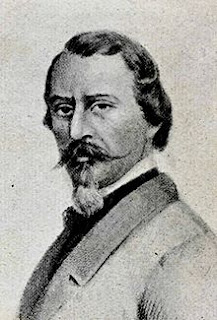History-loving writer dreamed of a united Italy
 |
| Aleardo Aleardi became an important figure in the Risorgimento movement |
At the height of his success he was hailed as an important figure in the Risorgimento movement and there is now a school named after him in the city of his birth.
Aleardi’s poems are mostly about events in Italian history and his love for his home country, which was under Austrian occupation while he was growing up.
He was originally named Gaetano Maria but changed his name to Aleardi, the surname of his father, Count Giorgio Aleardi, when he started writing.
Aleardi studied law at Padova University but gradually became more interested in poetry, influenced by some of his fellow students who were involved in the romantic Risorgimento movement.
Risorgimento, which means resurgence, was the name for the political and social movement that led to the consolidation of the different states of the Italian peninsula into the single state of the Kingdom of Italy during the 19th century. Most historians agree that the process began in 1815 with the end of Napoleonic rule in Italy and was completed in 1871 when Rome became the capital of the new united Italy and King Victor Emmanuel took up residence in the Palazzo Quirinale.
Aleardi’s first success came with Le Lettere a Maria (Letters to Mary), in which he expressed his belief in the immortality of the soul. He reached the height of his success with I Canti, a collection of poems published in 1864, which was reprinted eleven times.
Aleardi was sent to Paris in 1848 by Daniele Manin, a hero of the Risorgimento movement, to try to gather support for freeing Venice from the Austrians.
He was arrested and imprisoned by the Austrians twice, but survived the ordeals to become a member of parliament after Italian unification.
He became a senator in 1873 and then a professor of aesthetics in Florence, where he died in 1878.
 |
| The University of Padova, where Aleardi studied law before devoting his time increasingly to poetry |
The University of Padova, where Aleardi studied law, was established in 1222 and is one of the oldest in the world, second in Italy only to the University of Bologna. The main university building, Palazzo del Bo in Via 8 Febbraio in the centre of Padova, used to house the medical faculty. You can take a guided tour to see the pulpit used by Galileo when he taught at the university between 1592 and 1610.
 |
| The romantic so-called 'Juliet balcony' became an attraction for visitors to visitors to Verona |
Verona, where Aleardi was born, is the second biggest city in the Veneto. It is home to the first-century Roman Arena, famous for staging open air opera productions, and Casa di Giulietta, which has a romantic marble ‘Juliet’ balcony, although there is little evidence that the real-life Romeo ever stood below it declaring his love for Juliet.
Home












